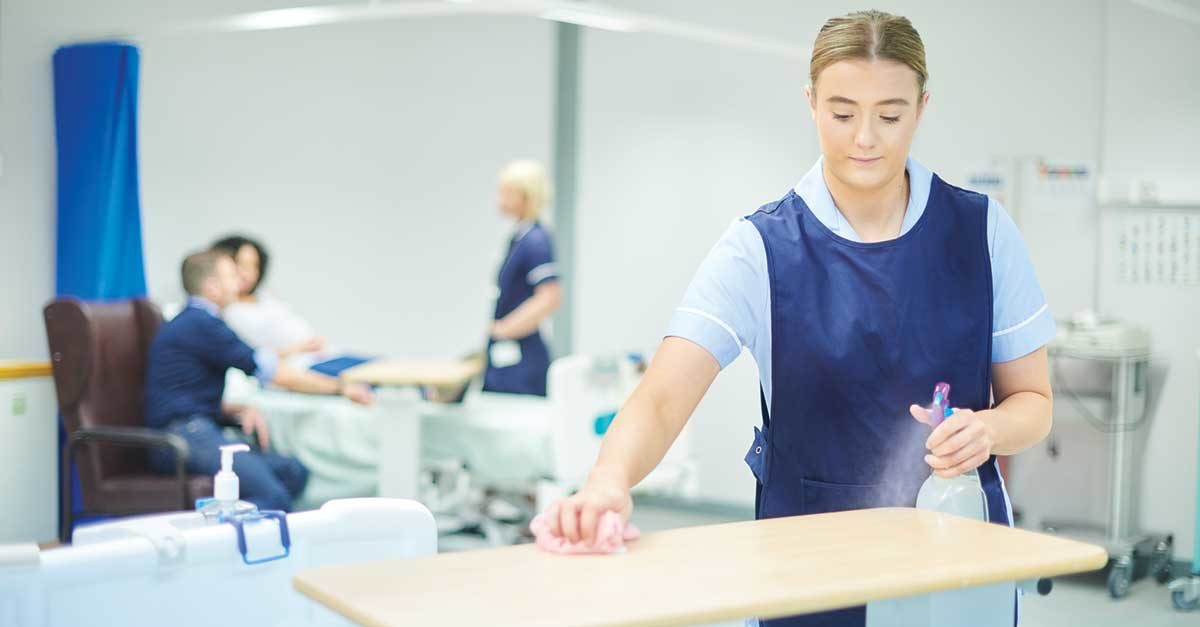During the pandemic, hospitals and health care facilities had to quickly learn, relearn, or simply step-up proper cleaning and disinfection protocols. While we are not completely out of the woods with COVID-19 variants currently escalating across the country, now is a good time to review and evaluate what has worked to date to ensure cleaning and maintenance staff at health care facilities remain properly protected within their environments. Keep in mind that even if we do manage to conquer COVID-19 and its variants, other harmful pathogens remain out there that can continue to make us sick. Now is not the time to let our guard down.
Review standard precautions
In health care, Standard Precautions is an underlying concept that teaches health care workers and environmental services staff (EVS) to assess the risk to themselves (or the environment) in advance of a patient interaction and to use appropriate interventions such as personal protective equipment (PPE), hand hygiene, and/or surface disinfection to address the risk. This will minimize the risk to the EVS worker or environment from becoming contaminated by the patient or the patient’s environment. While this approach has helped EVS team members to protect themselves from harmful pathogens, the concept needs to be reviewed in light of the presentation of COVID-19 in patients with no symptoms.
Key learning: In some cases, cleaning and maintenance workers may not be able to properly assess the risk of exposure prior to a patient interaction. Patients may have presented to an emergency department with a different medical concern, tested for SARS-CoV-2 and found to be positive, without signs or symptoms of COVID-19. The use of PPE can only be effective if the maintenance worker has a proper understanding of the pathogen likely to be encountered and the mode of transmission. Recommendations on regular use of face protection, and/or better air circulation within all buildings should be considered.
Plan for personal protective equipment
One thing we learned early during the pandemic is to never underestimate the quantity of PPE a hospital or health care facility should always have on hand. Early shortages left many facilities scrambling to find—and many times negotiate over—protective gear that should have been readily available to cleaning and maintenance workers on site. In some cases, stockpiles of PPE were available but had expired and were no longer usable.
Key learning: Any PPE required for a surge in infections (e.g., epidemic or pandemic) should be identified in advance to ensure there are no delays when it is ultimately required by cleaning and maintenance employees. And staff should be regularly trained on how to use said equipment, which includes the proper way to put it on, remove it, maintain it, and ultimately dispose of it. Fit-testing for respirators also needs to be done as required by regulatory bodies.
Ensure hand hygiene compliance
If there was one thing that was heard constantly during the pandemic, it was the importance of practicing good hand hygiene. And for good reason. Hands are known to spread pathogens. The pathogens can move from patient to EVS workers, workers to patient, or from people to the environment, and environment to people. During the pandemic we were indoctrinated to wash our hands regularly if soap and water were available, or to ensure that hand sanitizers were always in our possession. And the message was clear that we use these products consistently prior to eating, entering/leaving a room or building, using the bathroom, after shaking someone’s hand, etc.
Key learning: As mentioned above, even when we think we are following the proper protocols for hand hygiene, there is still a small risk that we did not kill or remove all pathogens. Beyond the frequency of hand washing, we need to also focus on the quality of hand hygiene. This includes focusing on all areas of the hands and on the duration of the hand washing process (at least 20 seconds of lathering with soap, or 20 seconds of rubbing with hand sanitizer). Health care facilities continuously monitor compliance of hand hygiene and should provide real-time feedback to cleaning and maintenance professionals on proper technique.
Mind the frequently touched surfaces
On a typical day, facility cleaning and maintenance workers touch a sequence of surfaces (and substances) that includes inanimate objects, patient skin, mucous membranes, food, waste, body fluids and, of course, the worker’s own body. Each hand-to-surface exposure presents an opportunity for a bidirectional exchange of pathogens between hands and objects/surfaces, even if gloves or gowns are worn. In this manner, pathogens can spread within the health care cleaning environment.
Key learning: Good hand hygiene, proper glove use, and adequate surface disinfection go hand in hand to reduce infection risk for patients and maintenance staff. While there’s little data that suggests the frequency surfaces should be disinfected, what we do know, for example, is that something as innocuous as a patient bedrail can be touched upward of 256 times per day, while typical surface disinfection is only done once a day. It is therefore recommended that health care facilities implement a thorough environmental hygiene program, with more frequent cleaning and disinfection of high-touch surfaces.
Do not overlook the floors
While environmental surfaces and hand hygiene get the lion’s share of attention in health care environments, floors have not typically been considered a high-risk surface for pathogen transmission. Because of this, floor hygiene is oftentimes ignored or given low importance. While the U.S. Centers for Disease Control and Prevention (CDC) guidelines currently address floor disinfection as a low priority, there is mounting evidence that points to floor contamination with pathogenic organisms that can include MRSA, VRE, and Clostridioides difficile (C. difficile).
Key learning: We are starting to see a clearer picture that shows how floors can act as a reservoir and may contribute to infection risk, especially in health care facilities. More research into proper floor maintenance (clean, sanitize, or disinfect) is required.
Use UV-C light as an added measure of insurance, not the only measure
UV-C light is increasingly being used in health care environments in addition to rigorous cleaning and disinfection processes to help add a measure of insurance to this process. In order for UV-C to be effective, the surfaces should be cleaned and disinfected before boosting disinfection with UV-C light. This is because UV-C light may not penetrate soiled surfaces effectively enough to kill potential pathogens of concern. UV-C light should be thought of as a supplement or added measure to a rigorous cleaning compliance program to enhance environmental hygiene.
Key learning: UV-C lights are not as simple as going into a room, turning them on and allowing them to work their magic unattended. There are a number of factors that affect the efficacy of the light, such as light intensity, distance of light from surface and the angle that the UV-C energy hits a surface (angle of incidence). Before investing in a UV-C system, compare the size of the unit, unit cycle times, energy draw, ease of use, and bulb replacement costs. Bulb replacement kits can cost less than US$1,000 and go upward of $10,000. And lastly, don’t forget about service agreement costs. We’ve seen some that are upward of $10,000 per year.
By following the aforementioned cleanliness protocols and learning from past experience about what has worked and what has not, health care EVS workers will be well prepared for the next infectious situation or issue.




